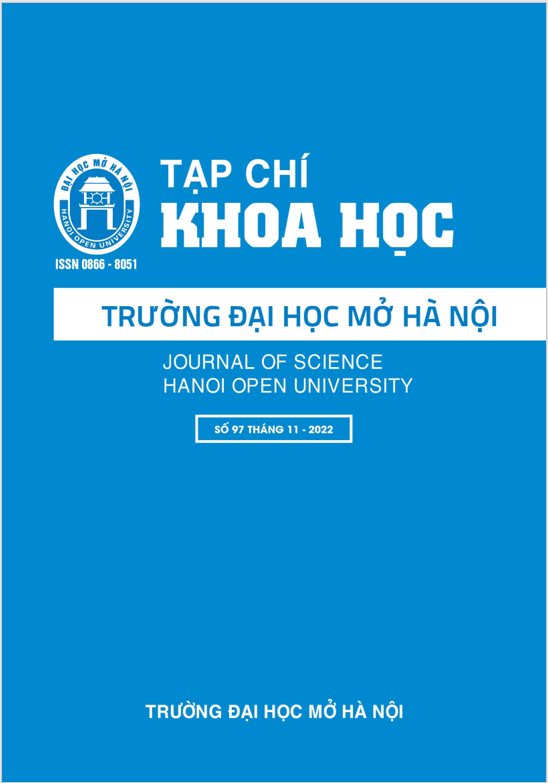IMPACT OF INCOME DIVERSIFICATION ON BUSINESS PERFORMANCE OF VIETNAM COMMERCIAL BANKS
Keywords:
Income of commercial banks, Business efficiency of commercial banks, Impact of income diversification on business performance of commercial banksAbstract
Commercial banks’ financial services to customers are also revenue- generating services for them. Therefore, in order to increase business performance, commercial banks must strengthen their provision of financial services to consumers, thereby boosting the bank’s income. However, expanding financial services offered to consumers in order to raise income does not imply that commercial banks would enhance their business efficiency. On the contrary, it might potentially impair commercial banks’ efficiency, as shown in several worldwide research studies. In recent years, the growth of financial services in Vietnam has grabbed the attention of commercial banks and produced extremely beneficial outcomes, allowing commercial banks to not only rapidly generate income but better satisfy the demands of clients in the economy. However, in terms of efficiency, it has fallen short of expectations, as seen by the comparatively low ROA or ROE coefficients when compared to commercial banks in other nations.
This paper provides empirical evidence on the impact of income diversification on the business performance of Vietnamese commercial banks from 2010 to 2020.
References
[1]. Antoniou, A., Guney, Y., & Paudyal, K. (2006). The Determinants of Debt Maturity Structure: Evidence from France, Germany and the UK. European Financial Management, 12(2), 161–194. doi:10.1111/ j.1354-7798.2006.00315.x
[2]. Chronopoulos, D. K., Girardone, C., & Nankervis, J. C. (2011). Are there any cost and profit efficiency gains in financial conglomeration? Evidence from the accession countries. The European Journal of Finance, 17(8), 603-621. https://doi.org/10.1080/1351847X.2010.538300
[3]. Cohen, J. (1988), ‘Set correlation and contingency tables’, Applied psychological measurement, 12(4), 425-434.
[4]. Delpachitra, S., & Lester, L. (2013). Non‐Interest Income: Are Australian Banks Moving Away from their Traditional Businesses?. Economic Papers: A journal of applied economics and policy, 32(2), 190-199.
[5]. DeYoung, R., & Rice, T. (2004). Noninterest income and financial performance at US commercial banks. Financial review, 39(1), 101-127. https://doi.org/10.1111/ j.0732-8516.2004.00069.x
[6]. DeYoung, Robert, and Gökhan Torna (2013): Nontraditional banking activities and bank failures during the financial crisis. Journal of Financial Intermediation 22: 397–421
[7]. Elyasiani, E., & Wang, Y. (2012). Bank holding company diversification and production efficiency. Applied Financial Economics, 22(17), 1409-1428. https://doi.or g/10.1080/09603107.2012.657351
[8]. Elsas, R., Hackethal, A., Holzha¨user, M. (2010). The anatomy of bank diversification. Journal of Banking and Finance 34 (6) 1274–1287
[9]. Ngân Giang (2021): Vay tín dụng đen lãi suất lên đến 1.700%/năm. https://infonet.vietnamnet.vn/doi-song/nhip- song/vay-tin-dung-den-lai-suat-len-den-1- 700-nam-399217.html
[10]. Lê Long Hậu & Phạm Xuân Quỳnh (2016). Tác động của đa dạng hóa thu nhập đến hiệu quả kinh doanh của các NHTM Việt Nam. Tạp chí Công nghệ ngân hàng, 124, 11- 22.
[11]. Bùi Thúy Hằng (2019): Cho vay ngang hàng, kinh nghiệm Trung Quốc, Indonesia và khuyến nghị đối với Việt Nam. Tạp chí Ngân hàng. Số 13
[12]. Nguyễn Mạnh Hùng & Tạ Thu Hồng Minh (2020): Thực trạng hoạt động cho vay ngang hàng tại Việt Nam. https://tapchicongthuong.vn/bai-viet/thuc-trang-hoat-dong-cho-vay- ngang-hang-tai-viet-nam-76652.htm
[13]. Nguyễn Ngọc Khánh (2021): Tác động của đa dạng hóa thu nhập đến hiệu quả hoạt động của các NHTM Việt Nam. Luận án Tiến sĩ Tài chính – Ngân hàng. Học viện Ngân hàng
[14]. Lee, C. C., Hsieh, M. F., & Yang, S. J.(2014). The relationship between revenue diversification and bank performance: Do financial structures and financial reforms matter?. Japan and the World Economy, 29, 18-35. https://doi.org/10.1016/j.japwor.2013.11.002
[15]. Lepetit, L., Nys, E., Rous, P., & Tarazi, A. (2008). Bank income structure and risk: An empirical analysis of European banks. Journal of Banking &Finance, 32: 1452-1467.
[16]. Hồ Lê (2020): Tăng trưởng tín dụng giảm nhưng nền kinh tế vẫn đi vay ngày càng nhiều. https://viettimes.vn/tang-truong-tin-dung-giam-nhung-nen-kinh-te-van-di-vay- ngay-cang-nhieu-post122465.html
[17]. Mercieca, S., Schaeck, K., & Wolfe,S. (2007). Small European banks: Benefits from diversification?. Journal of Banking & Finance, 31(7), 1975-1998. https://doi. org/10.1016/j.jbankfin.2007.01.004
[18]. Meslier, C., Tacneng, R., & Tarazi, A. (2014). Is bank income diversification beneficial? Evidence from an emerging economy. Journal of International Financial Markets, Institutions and Money, 31, 97-126. https://doi.org/10.1016/j.intfin.2014.03.007
[19]. Hồ Thị Hồng Minh & Nguyễn Thị Cành (2015). Đa dạng hóa thu nhập và các yếu tố tác động đến khả năng sinh lời của NHTM Việt Nam. Tạp chí Công nghệ ngân hàng, 106+107, 13-23
[20]. Hà Phương (2020): Ngân hàng nào chưa hoàn thành 3 trụ cột Basel II?. https:// diendandoanhnghiep.vn/ngan-hang-nao-chua- hoan-thanh-3-tru-cot-basel-ii-166944.html
[21]. Sanya, S., & Wolfe, S. (2011). Can banks in emerging economies benefit from revenue diversification?. Journal of Financial Services Research, 40(1), 79-101. https://doi. org/10.1007/s10693-010-0098-z
[22]. Nguyễn Minh Sáng (2017). Tác động của đa dạng hóa thu nhập đến hiệu quả hoạt động của các NHTM tại Việt Nam. Tạp chí Kinh tế & Phát triển, 241, 40-49
[23]. Stiroh, K. J., & Rumble, A. (2006). The dark side of diversification: The case of US financial holding companies. Journal of banking & finance, 30(8), 2131-2161. https:// doi.org/10.1016/j.jbankfin.2005.04.030
[24]. Hoàng Sơn (2019): Ứng xử phù hợp với tín dụng phi chính thức. https://saigondautu. com.vn/tai-chinh/ung xu-phu-hop-tin-dung-phi-chinh-thuc-64975.html.
[25]. Nguyễn Thị Đoan Trang (2019). Tác động của đa dạng hóa thu nhập đến hiệu quả kinh doanh của NHTM Việt Nam. Tạp chí kinh tế và ngân hàng châu Á, 161, 33-49
[26]. Đỗ Phú Thọ (2014): Ra ngõ gặp ngân hàng – Sự cạnh tranh khốc liệt giữa các nhà bank và KH hưởng lợi.
[27]. Quốc Thụy (2020): Top 10 ngân hàng có nhiều chi nhánh, phòng giao dịch nhất
https://vietnambiz.vn/top-10-ngan-hang- co-nhieu-chi-nhanh-phong-giao-dich- nhat-20200601180743593.htm
[28]. Vennet, R. V. (2002). Cost and profit efficiency of financial conglomerates and universal banks in Europe. Journal of Money, Credit and Banking, 254-282. https://www. jstor.org/stable/3270685
[29]. Vinh, V. X., & Mai, T. T. P. (2015). Lợi nhuận và rủi ro từ đa dạng hóa thu nhập của NHTM Việt Nam. Tạp chí phát triển kinh tế, 26(8), 54-70.
[30]. World Bank (1992): “Future Direction of Brach Banking”. Fox, R Gerald. World of Bank 11 no.3.
